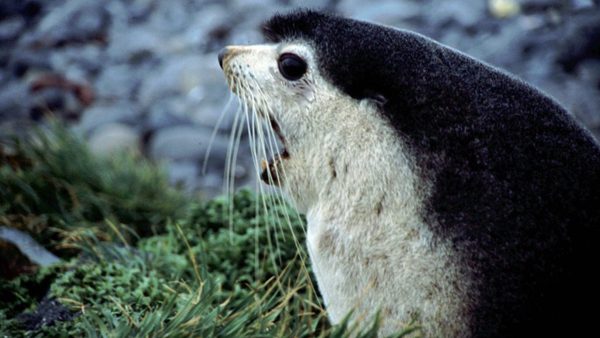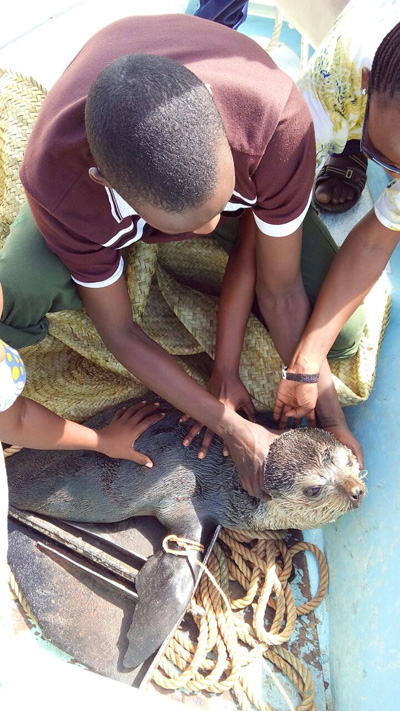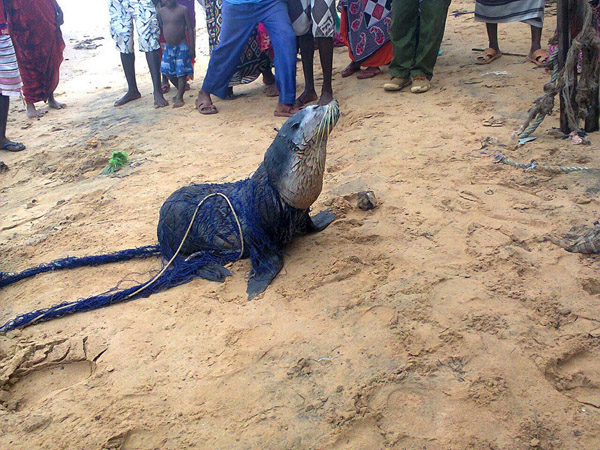This fur seal was recently caught (and released) from a fisher’s net in Kenya – more than 4,000 miles from its home. It’s farther north than any Subantarctic fur seal has ever been recorded, by 115 miles.
George Waweru Maina, The Nature Conservancy’s marine projects coordinator in Kenya, helped identify the mystery beast; the fishers that caught it in their net had never seen anything quite like it. (Read Maina’s Treehugger blog on the incident and what it means for marine conservation).
To put it in context, it’s as if a Yellowstone grizzly bear went on walkabout and ended up on the beaches of Costa Rica.
That’s perhaps an imperfect comparison. Conservationists frequently laud the grizzly’s ability to roam, but it moves between mountain ranges, not whole oceans. The Subantarctic fur seal is a frequent and accomplished long-distance traveler.
But even by its wide-ranging standards, this one was very, very far from its usual haunts – from its haul-out islands, from other seals.
How did it end up in Kenya?

For answers, I turned to Greg Hofmeyr, seal researcher with the Port Elizabeth Museum in Port Elizabeth, South Africa.
He shed light on the Subantarctic fur seal’s biology, habits and conservation – all of which may help understand why this seal turned up an ocean away from its compadres.
The Subantarctic fur seal, Hofmeyr says, lives on islands along the Antarctic polar front in the Southern Ocean, the waters surrounding Antarctica and south of Africa, Australia and South America.
You may have not heard of their remote island homes – their largest populations are found on Gough Island, the Prince Edward Islands and Ile Amsterdam. These three island groups are home to an estimated 99 percent of the population.
These islands are 1,200 miles south of South Africa. All the seals haul out on islands in this area. But they are roamers – known for swimming vast distances.
“A female fur seal will forage for food hundreds of kilometers away, and then return directly to her pup without problem,” says Hofmeyr. “Other seals swim thousands of kilometers and return to their island. The ocean may look featureless to us, but it doesn’t to a fur seal.”
Hofmeyr is familiar with the species: he has studied them in the field on the Prince Edward Islands. And each year, 4-8 fur seals turn up off the Eastern Cape of South Africa, where he works and lives.

With their yellowish face and chest, they are quite distinctive animals.
They also are easy to distinguish from the local Cape fur seals (you may know this species as the one that is frequently devoured by great white sharks during “Shark Week”). Cape fur seals are homebodies – they almost never stray from the continental shelf of southern Africa.
The subantarctic fur seals that show up in South Africa are a long way from home. Why?
“The one thing we know is that they are almost always immature animals or young adult males,” says Hofmeyr. “The young animals may have an inherent desire to explore the world, more so than adults.”
So could this be the fur seal equivalent of a college graduate backpacking across Europe?
Well, perhaps. Or maybe the fur seal is dispersing to look for new colonies of seals: a youngster in search of its own turf.
The Subantarctic fur seal faced extinction twice, in the early 1800s and again in the late 1800s and early 1900s. In both cases, hunters overharvested them for their pelts.

The last hunt occurred in 1921 on the Prince Edward Islands, and since then the population has rebounded dramatically. More than 400,000 Subantarctic fur seals now exist, and their populations are considered healthy.
“One idea why Subantarctic fur seals are being found thousands of kilometers away is tied to that population increase,” says Hofmeyr. “They are not overpopulated. But some islands may have reached carrying capacity, so the young animals go off in search of new habitat.”
The coast of Kenya is more than 3,000 miles away from South Africa – and only a couple of seals have made it anywhere close to that far north. Did this seal become disoriented? Was it still desperately searching for other fur seals?
Researchers simply don’t know.
“When fur seals haul out on islands, they’re very social, living in huge colonies,” says Hofmeyr. “At sea, they seem to be more solitary, but we don’t know for sure. By radio tagging, we know the depths they dive and where they’re feeding, but we don’t know what other seals are around.”
Hofmeyr and other researchers have been placing flipper tags on Subantarctic fur seals found off the coast of South Africa. They have also begun using more expensive satellite tags to find out where the animals go once they leave South Africa.
Do they return to their haul-out islands, or do they continue wandering?
Much remains to be learned. Perhaps more vagrant fur seals will be showing up along the African coast as their populations continue to grow.
As far as the record-breaking fur seal in Kenya, it has a fortunate story. Captain Mohamed Lali Kombo and his two crew members caught the fur seal in their nets.
They could have killed this strange creature, but they knew there were conservationists and rangers in a nearby coastal community. They took it there for identification, and it was safely released.
The rescue comes at a hopeful time for marine wildlife off the coast of Kenya. The Conservancy’s Waweru Maina, who helped identify the seal, was on the coast working with communities on new fishing co-management plans for the area. One of the new regulations will manage the use of gill nets that entangle fur seals and other marine mammals in deep water.
The next Subantarctic fur seal to show up off the coast of Kenya may thus avoid the nets entirely. Perhaps it will keep swimming and searching. Perhaps it will haul out on a nearby island.
Even as researchers learn more about these animals, though, much will likely remain unknown. The motives of wandering seals will remain out of our grasp. A mystery.




What species of seals are found in Kenyan rivers? Is it strange to find seals in a Kenyan river?
They have no maps, but know their way back. Great navigation indeed!
Wow…
A few years ago (around 2003, if I’m not mistaken), I was working with a conservational organization here in Northeast Brazil (8°3′S 34°54′W) and we were surprised by a lost pup of those beautiful buggers (A. tropicalis). Unfortunately, it was very young, sick and debilitated, and no matter our efforts, he didn’t survive… Glad to know this one was luckier.